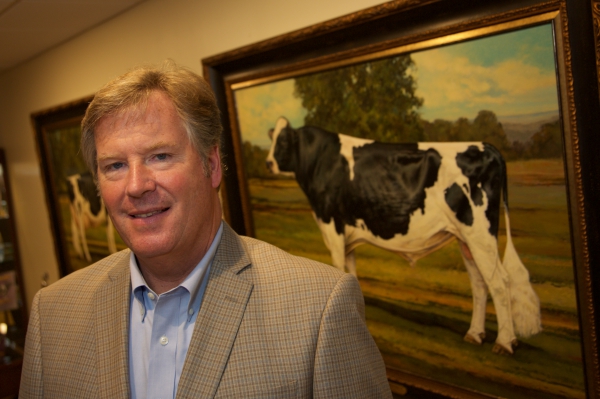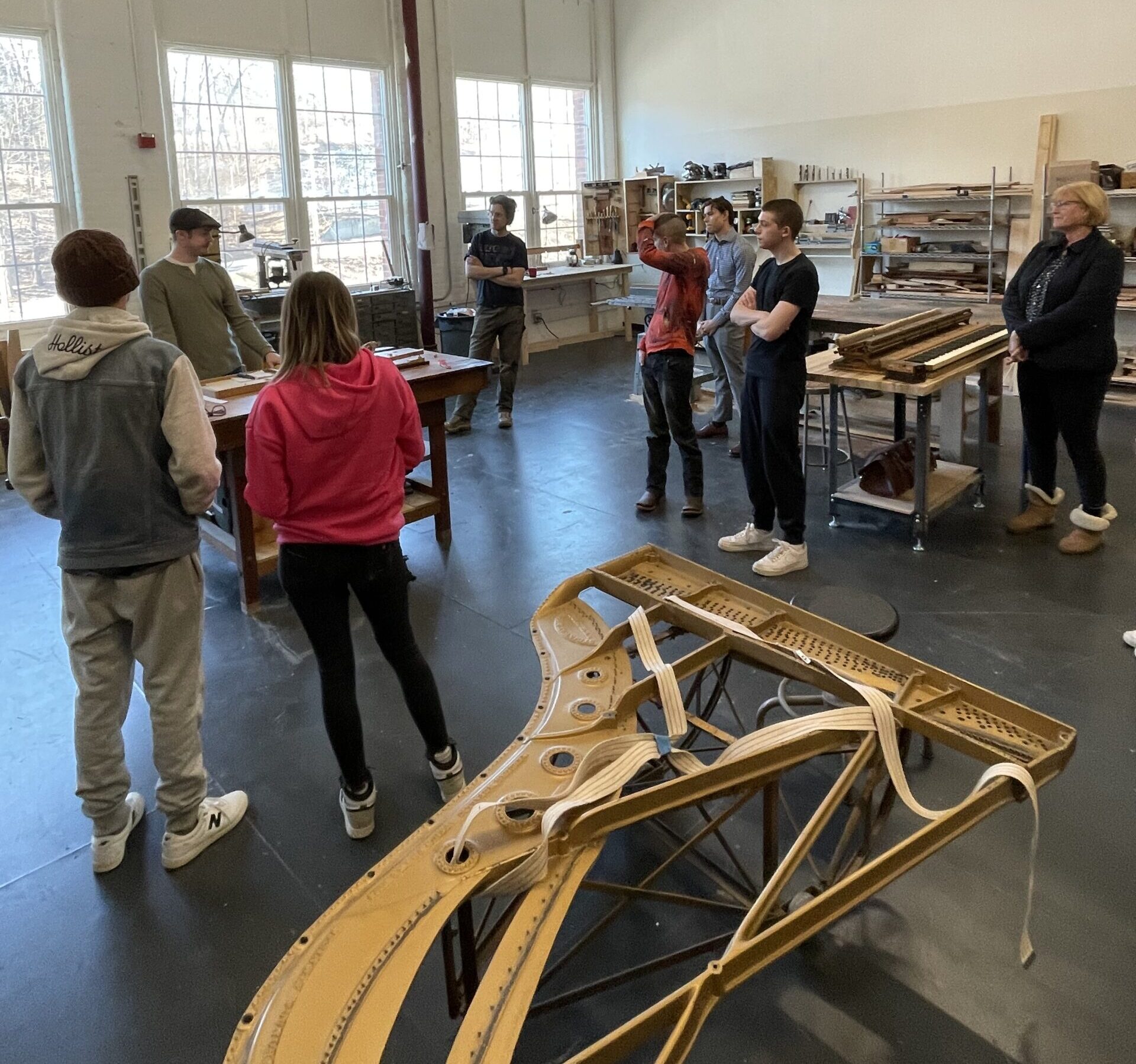
A conversation with John Meyer, Holstein Association USA
By age 6, he was already fascinated with dairy farming and the folks doing it. At 56, that fascination thrives — in the executive suite.
By Jerry Goldberg/
BRATTLEBORO—JOHN MEYER and I met in late 2005 when I was brought on as executive director of the Brattleboro Area Chamber of Commerce. John was a member of the Chamber board and though he had no direct hand in my hiring, he was from the first one of my champions. I was then and am now most grateful to him.
When we sat down in a meeting room at the Holstein Association USA’s headquarters at 1 Holstein Place in Brattleboro, I was reminded immediately of John’s professionalism, his preparedness and his unerring willingness to get to the heart of the matter. As our chat went on, I saw clearly his passion for the work of the organization he leads so skillfully.
As this meeting was a first for us post-Chamber — I no longer a hired hand and he no longer a boss-board-guy — we came together as equals.
Well, as close to equals as is possible.
After all, I’m as far from being an aggie as you can get, and John’s consummately — and elegantly — of the land. Put it this way: I’m not a cow guy and he is.
So, dear reader, meet my friend John Meyer — and his Holsteins!
* * *
Jerry Goldberg: To start us out — sort of set the scene — please tell us a bit about this breed of milk cattle. What makes a Holstein a Holstein?
John Meyer: Its history and geography define the ancient breed, which dates back in its earliest form to about 100 B.C.
As Germanic people moved into and settled northern Europe, word had spread that there were vast tracts of land unsurpassed for grass production and therefore perfect for the feeding and raising of cattle.
Herders from the area that’s now known as Schleswig-Holstein in northern Germany drove their black Batavian cattle to Friesland and northern Holland, in The Netherlands of today, where they were bred with the local white Friesian cattle. That special relationship between breed and land has held strong even until today.
J.G.: What is it about Holstein cattle that makes it — as you said in your State of the Association remarks to the Holstein Association USA 2016 Annual Meeting — “our beloved breed”?
J.M.: Well, for starters, Holsteins are the world’s highest-production dairy animals. They’re bred to use the consumption of grass most efficiently. Although there are parts of Europe where they may be used for beef production, here in the U.S. they’re used primarily for their milk, which is as high-quality as exists today.
J.G.: Let’s talk about Holstein Association USA. I suspect there are a lot of folks who don’t know much about what goes on behind those walls at the south end of Main Street.
J.M.: First, let me say that there are no actual Holsteins in residence here, though we may get a visitor every once in a while.
Holstein Association USA is a national membership organization based here in Brattleboro. We currently have more than 30,000 members, which makes it the largest dairy breed association of its kind in the world. It’s governed by dairy farmers for dairy farmers.
Holstein’s essential reason for being is to build, nurture, and sustain a vibrant dairy industry. Education is a big part of our work — developing future dairy leaders worldwide.
We’re also a pedigree livestock association providing genealogies of registered Holstein cattle. So, just as you and I might look at our family tree and our ancestral background, Holstein Association USA does the same for dairy cattle and has since the first Holsteins were brought here in a shipment to Boston from the Netherlands in 1852.
J.G.: You’re listed on your website as chief executive officer — and also as executive secretary. We don’t run into too many people with that title anymore, John. I wasn’t sure that what I’d read was referring to you.
J.M.: Yes, both would be me. See, back in the earliest day, the person in my position also did all of what later came to be known as secretarial work — keeping member ledgers and herd records.
J.G.: Tell me more about those beginnings.
J.M.: In 1885, the Association of Thoroughbred Holstein Cattle and the Dutch-Friesian Association of America merged to form the Holstein-Friesian Association of America in Iowa City, Iowa, the hometown of the first executive secretary, a dairy farmer named Thomas Wales. (The CEO title came later.)
It was not uncommon at that time for breed associations to operate out of the actual homes of the dairymen who were active in the importations of cattle.
J.G.: OK. Holsteins came into Boston and herds spread throughout New England, New York state, and westward. How’d it happen that the Association ended up in Brattleboro?
J.M.: The second farmer to hold the position — in 1894 — was F. L. Houghton, who moved the Association to his home farm in Putney, where the farm still exists adjacent to the Putney School.
In 1903, Houghton had been working on Holstein Association business out of his house for about nine years until ordered by his family to reclaim their home. The Association rented space in downtown Brattleboro and in 1917 constructed the building we’re in today and where we have been for 99 years.
J.G.: Sounds like you’ve got a big anniversary coming up! A Brattleboro bash, right? So tell us how it happened that you made your way to Brattleboro.
J.M.: I was born and raised in Fort Atkinson, a town about the size of Brattleboro nestled between Madison and Milwaukee in southern Wisconsin. Although I didn’t grow up on a farm, both of my parents did — my mother on an Angus beef spread in north-central Iowa and my father on a Holstein and Guernsey farm in northeastern Iowa.
I spent about six weeks every summer from grade school through high school on both my grandparents’ farms and loved every minute of it — the people, the lifestyle, caring for the animals, the crop work. So even though we were townies, the farms were never far away.
My father edited Hoard’s Dairyman magazine, which was founded by William Dempster Hoard, Wisconsin’s 16th governor. It is the largest publication covering the dairy industry in the world and considered the dairy industry bible. I devoured my bimonthly copies of it like I would Sports Illustrated! I also spent a lot of after-school and weekend time at the magazine’s research farm about a mile from our house.
While I was growing up, people who were passionate about the industry flowed into Fort Atkinson and the Hoard’s Dairyman farm, and they often came to our home. I enjoyed listening to them and even engaged them in conversation about dairy farming. I was told by a former Holstein USA CEO that he remembered meeting me in our home in Fort Atkinson when I was about 6 years old! Maybe a tad precocious…?
J.G.: So with farming such a big part of your childhood… you can guess my next question, right?
J.M.: Of course. Why didn’t I become a farmer? Well, by not growing up per se on a farm and with the high expense of developing a farming operation, I knew that I’d never be a dairy farmer or a farmer of any sort.
See, farmers have to have lots of skills — mechanical ability being one. And mechanical ability isn’t one of my sweet spots, as my wife Vicki would attest to.
J.G.: So there you are in 1977 — a not-to-be farmer in farm country — with high school behind you. What came next?
J.M.: I enrolled in the University of Wisconsin-Eau Claire and majored in education, with the idea that I’d be a teacher and coach an athletic team. Eventually, I switched to business marketing and management.
I graduated in 1981 and until 1996 served in marketing and sales-management positions for two agriculture-related businesses. That year, the Brown Swiss Cattle Breeders’ Association based in Beloit, Wisc. was looking for a CEO/executive secretary — there’s that title again! — and they called me.
J.G.: Pardon my asking, but what made them think of you? After all, for all practical purposes you hadn’t been “down on the farm” for more than 15 years!
J.M.: Even though I wasn’t working directly inside the industry, I did participate in cattle shows. I put in weekends helping maintain the farms my families had in Iowa — which, by the way, I do to this day. Anyway, I was visible. People saw me around.
J.G.: Sounds like a good lesson in agri-networking.
J.M.: I guess you’re right!
Over the years I’d gotten to know and respect many of the folks that have served in these industry leadership roles. They’d been family friends. I decided to pursue the Brown Swiss position because as they said it’d be a great opportunity for me, a way to combine my vocation (business management) with two of my passions (dairy cattle and agriculture). I got and took the job in ’96.
About five years later, in late 2000, Holstein CEO Steve Kerr announced that he would be leaving after just shy of 10 years. His was one of the plum jobs in the world’s dairy industry, and the board and a national search firm conducted an exhaustive search — so exhaustive that we went through about five rounds of interviews.
They even brought Vicki and me in for a weekend. We had a great time here in the Brattleboro area. It felt like home from the start.
Anyway, they hired me and we moved here in July of 2001.
J.G.: How’s it been for you and Vicki — living here these 15 years?
J.M.: We love it. We’ve thoroughly enjoyed Brattleboro — the many cultural and outdoor diversions, the interesting people, the very “goodness” of the community — and the Vermont outdoors lifestyle. We really enjoy hiking and spending time in the countryside. We found a house in West Brattleboro that we love.
As for my work, I couldn’t ask for a better job. And I couldn’t ask for a better group of people to work with every day. These are tremendous people — the best.
J.G.: What should we know about Holstein Association USA’s role as a corporate citizen of the Brattleboro business community?
J.M.: We’re a consistent economic catalyst for Brattleboro, currently employing 125 individuals. Today, there are 75 working here in this office — in information technology, identification services, genetic services, member and customer services, finance, human resources, communications, and maintenance.
We have about 40 people in the field and a dairy records processing center in Visalia, Calif. that employs 12.
Here’s something I’ve been thinking about recently. We’ve been here since 1903 — it’s been 113 years — and to our best account, we’ve employed more than 4,000 individuals over that period of time. So with Brattleboro maintaining a population of about 12,000 pretty consistently over that time — and taking into account, of course, that the 4,000 didn’t work at Holstein at one time — the question is: Where would these 4,000 people have worked had they not worked here?
Also, as a nonprofit, our Association contributes over $20,000 a year to other nonprofits. Not many of us are in a position to do that, and thank goodness we are. Conservatively, when you factor in the effect of wages and jobs created at other local companies providing products and services to us and our employees, we calculate Holstein Association USA’s overall contribution to the Brattleboro area economy to be well over $8 million a year.
J.G.: That’s remarkable. Elaborate, please!
J.M.: Of course. There are many people, both within the United States and around the globe, who know of Brattleboro because of the Holstein Association. We regularly bring people to the area from around the globe. I’d guess that we’re probably as well-known and -connected nationally and internationally as any business in town.
I’ve gone all over the world with a Holstein Association USA–logoed shirt on and people will stop me because they recognize it. Some guy, say from Washington State, will see me in the Seattle airport and comment. They know us. And they know Brattleboro.
J.G.: I love walking billboards, John!
J.M.: Once a Chamber guy….
Most nights of the year, we’ve got somebody staying in a Brattleboro hotel, which means we spend more than $17,000 a year for local hotel rooms for our guests. We also spend a lot of money at local eateries and shops. This steady local spending helps make it possible for the Brattleboro area to maintain good restaurants and hotels.
J.G.: Those numbers are astonishing. How wonderful for our town!
J.M.: The important part is that we’re talking about an influx of money — new money — coming into the area every day from all across the United States — California, Iowa, Florida, you name where — and, of course, from around the world. Over 99 percent of the money we bring in to Windham County would not circulate within our communities if Holstein were in Iowa City, Iowa or some other town. That’s something that people don’t think about. Add to it the taxes and fees — rooms and meals and sales — and like I said, we’re making a difference.
J.G.: That new-money piece is critical. Generating tourism does its share, of course; but for consistency, businesses like Holstein that provide that level and frequency of revenue generation are key to our economic health. Thanks for that!
J.M.: There are even more numbers most people don’t know about. Every year Vermont Business magazine publishes its “Vermont Top 100 ” list of businesses and nonprofits based on annual revenues.
Holstein Association USA is the 94th largest — we usually fall somewhere between 90th and 95th. Then within the Brattleboro community, the Brattleboro Retreat, Brattleboro Memorial Hospital, GS Precision, and the Cersosimo companies are the only local organizations that generate more revenue annually than we do. So here we are — the 94th largest in the state and the fifth largest in town!
J.G.: I noticed on your site the words “membership” and “registrations”….
J.M.: People choose to be a member of this association just as they’d choose to be a member of the Chamber of Commerce or any membership-based organization.
But unlike those that ask for credentials, we don’t require that you raise or milk registered Holsteins. All you need is an interest in the dairy industry and a desire to be part of an organization representing the dairy industry nationally.
Like I said, we’re governed by dairy farmers and work for dairy farmers — on many levels. One is representation, which means we’re active in Washington, D.C. on a variety of agriculture and dairy issues.
Some choose to be a part of our organization because it’s vital to their business. Others like me might have milked cows as kids and don’t anymore, yet we still love the idea of dairy farming.
Which reminds me: a lot of young people who are in farming or thinking about it choose to be a part of our association because of our many education programs. That’s a big calling card for us.
Now to registration. Say you’re a member and you bought a calf or heifer from the Miller Farm in Vernon, also a member. They’d have a registration paper describing the lineage of the animal — sort of like your family tree — that will accompany that animal going forward.
Today, with the whole farm-to-fork movement, people really want to know where their food comes from. With our systems we’d know that this animal was born on the Miller Farm on Jan. 15, 2016 and maybe spent its whole life on that farm — or was sold when it was about 2 years old to a dairy in Rutland or wherever. It is always a good idea to have an animal’s history and lineage available.
We also collect data on that heifer so when she becomes a cow and has her first calf and starts milking, we’ll know how much milk she produces in a year, the percent of protein and butterfat in her milk — all of those criteria.
The more information available on an animal, the better care you’re able to give it.
J.G.: As a nonprofit organization, what does success look like to you all at Holstein? How do you know, as former NYC Mayor Ed Koch would ask, “How am I doin’”?
J.M.: The dairy business can be volatile with milk prices going up and down. We work on programs that might help level those things out. So to answer your question, success is really measured by how vibrant the dairy industry is — and also how much better educated the people in the industry are about what they do, how they do it, and what growth and improvement look like.
J.G.: Funny to hear that about the dairy business which, if one were to brand it, would be known for a whole lot of things other than instability. The image of pastoral loveliness and gentleness and timelessness is what you’ve all managed to present — and you’ve done it quite well.
J.M.: Of course. But like any craft, dairying is a craft in and of itself, hopefully one that people will become better at as they do what they do every day.
We’re working to make sure the dairy industry is viable and vibrant. So back to your question: I measure success by the stability of the dairy farmers in the United States. If they’re doing well, I’m happy.
J.G.: Over the course of the years — during which, as you say, thousands of people have worked at Holstein — how has it been to find people to fill open jobs?
J.M.: Recruitment is definitely one of the most challenging aspects of my position. I have a hand in the hiring of everyone we bring into this organization. I think we’ve done remarkably well in maintaining a stable Holstein workforce, which is a real credit to the people in the greater Brattleboro area. We currently have several team members who’ve been at Holstein for more than 40 years, and we’ve even had people who worked here for more than 50 years.
But it seems to be getting harder all the time. Our new communications coordinator, who started on July 5, came up here from southeastern Pennsylvania.
Some of our positions are quite specialized. For example, we have four Ph.D. geneticists on our staff. As you know, there aren’t a lot of those running around Brattleboro or even Windham County, so we have to recruit all over the country — and that’s challenging.
Then there’s housing.
We have a heck of a time finding suitable housing for middle- to upper-middle-income people who want a nice place to live in, yet can’t afford many of the houses on the local market. Or maybe they can afford the purchase but are thinking that they want to work here for a year or two to see how it all pans out and would prefer to rent before committing to buying.
So I think there is also a void for that middle- to upper-middle-income person who wants an apartment or condo appropriate to their situation.
J.G.: Is there anything else on the recruitment front that challenges your organization?
J.M.: Sure. We’ll identify that Ph.D. or geneticist or someone for some other position, and then she can’t find a local position for her husband. She’s all set, but what’s out there for her spouse who has such-and-such a background? So we can lose them.
J.G.: Holstein’s been around in this community for a very long time. There’s surely a story out there. Do you think it’s the story that you’d like to be going around?
J.M.: Over the years we’ve probably been our own worst promoter. We go about our work quietly and I think the majority of the Brattleboro community has little to no idea what we do here.
I’d call us a modest organization. We’ve never blown our own horn, nor do we seek photo ops. We just don’t. And while we’re engaged locally, we are not as well-known as some businesses.
As a national business, we don’t really get local business traffic coming in our door, which is a big reason why more people don’t know more about us.
J.G.: Hey, this is the first time I’ve set foot in the building. And I’ve been in town for 20 years!
J.M.: We’re active members of the Brattleboro Area Chamber — I was on the board. We are generous contributors to Brattleboro Memorial Hospital; I served for many years on that board. Our contributions go to more than two dozen Brattleboro nonprofits. We do all these things in downtown Brattleboro, as a good corporate citizen should, yet we’re almost invisible.
So I think our story isn’t particularly well told. We could probably do a better job of self-promotion — if that’s what we really want to do. At the same time, I think we’re comfortable quietly going about our business and giving quiet support.
J.G.: You’re a major force in this town, in the industry, everywhere. To use a currently common expression, you’re huge. A star industry for us. You anchor this part of downtown — you, Sam’s, and the food co-op are the big kahunas down here.
J.M.: From what I can tell I think we’re the longest continually operated business in Brattleboro.
J.G.: Wow! Who knows that? And with all the contributions that you make in this community!
Our corner of the state is dealing with serious people at Holstein. You’re a big deal — an imposing, serious organization doing serious and important work and known internationally. The community should be able to know and voice that collectively.
Your presence should be a selling point for this area. Good jobs don’t come easily. We need more organizations like yours — that provide not just jobs, but opportunities for careers.
J.M. I owe this community so much — through Holstein and personally — both Vicki and I do. You’ve inspired some thought here, Jerry. Thank you.



